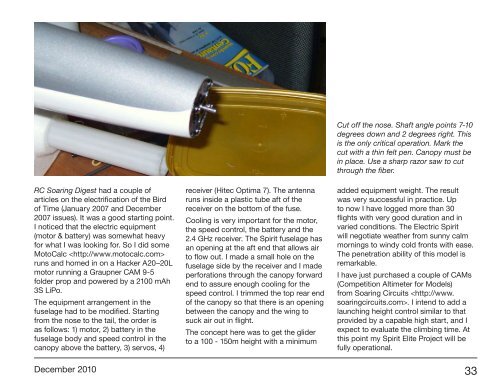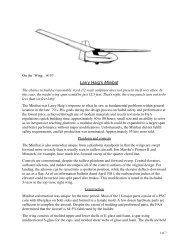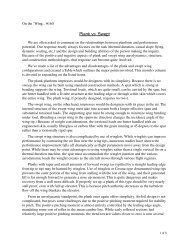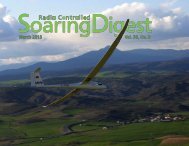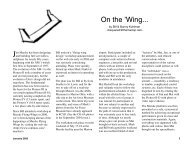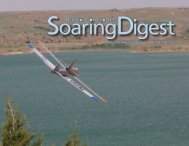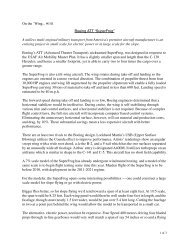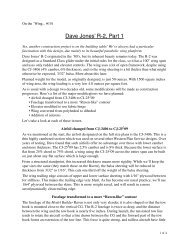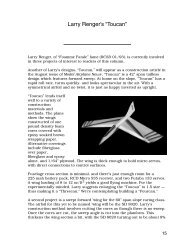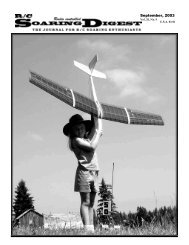Radi C ntr lled - Radio Controlled Soaring Digest
Radi C ntr lled - Radio Controlled Soaring Digest
Radi C ntr lled - Radio Controlled Soaring Digest
You also want an ePaper? Increase the reach of your titles
YUMPU automatically turns print PDFs into web optimized ePapers that Google loves.
RC <strong>Soaring</strong> <strong>Digest</strong> had a couple of<br />
articles on the electrification of the Bird<br />
of Time (January 2007 and December<br />
2007 issues). It was a good starting point.<br />
I noticed that the electric equipment<br />
(motor & battery) was somewhat heavy<br />
for what I was looking for. So I did some<br />
MotoCalc <br />
runs and homed in on a Hacker A20–20L<br />
motor running a Graupner CAM 9-5<br />
folder prop and powered by a 2100 mAh<br />
3S LiPo.<br />
The equipment arrangement in the<br />
fuselage had to be modified. Starting<br />
from the nose to the tail, the order is<br />
as follows: 1) motor, 2) battery in the<br />
fuselage body and speed co<strong>ntr</strong>ol in the<br />
canopy above the battery, 3) servos, 4)<br />
receiver (Hitec Optima 7). The antenna<br />
runs inside a plastic tube aft of the<br />
receiver on the bottom of the fuse.<br />
Cooling is very important for the motor,<br />
the speed co<strong>ntr</strong>ol, the battery and the<br />
2.4 GHz receiver. The Spirit fuselage has<br />
an opening at the aft end that allows air<br />
to flow out. I made a small hole on the<br />
fuselage side by the receiver and I made<br />
perforations through the canopy forward<br />
end to assure enough cooling for the<br />
speed co<strong>ntr</strong>ol. I trimmed the top rear end<br />
of the canopy so that there is an opening<br />
between the canopy and the wing to<br />
suck air out in flight.<br />
The concept here was to get the glider<br />
to a 100 - 150m height with a minimum<br />
Cut off the nose. Shaft angle points 7-10<br />
degrees down and 2 degrees right. This<br />
is the only critical operation. Mark the<br />
cut with a thin felt pen. Canopy must be<br />
in place. Use a sharp razor saw to cut<br />
through the fiber.<br />
added equipment weight. The result<br />
was very successful in practice. Up<br />
to now I have logged more than 30<br />
flights with very good duration and in<br />
varied conditions. The Electric Spirit<br />
will negotiate weather from sunny calm<br />
mornings to windy cold fronts with ease.<br />
The penetration ability of this model is<br />
remarkable.<br />
I have just purchased a couple of CAMs<br />
(Competition Altimeter for Models)<br />
from <strong>Soaring</strong> Circuits . I intend to add a<br />
launching height co<strong>ntr</strong>ol similar to that<br />
provided by a capable high start, and I<br />
expect to evaluate the climbing time. At<br />
this point my Spirit Elite Project will be<br />
fully operational.<br />
December 2010 33


